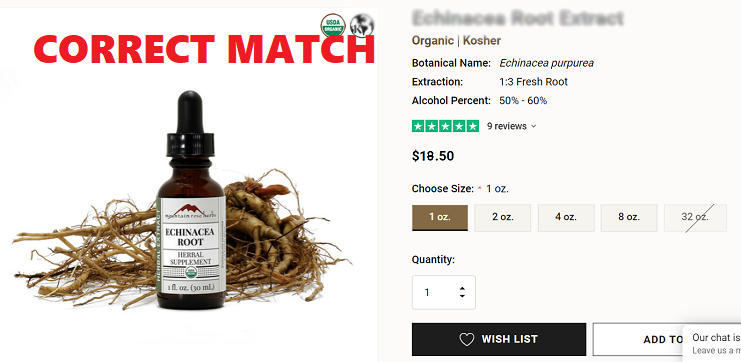Product matching accuracy is a fairly abstract concept, and abstract things are usually not so easy to understand. Therefore, lets first explain in a bit more illustrative way.
Please take a good look at two products featured below. Are they a match? (or, in other words, are they identical?)

Lets suppose that we reach conclusion that they are a match. And lets suppose that the Category manager of Website B is not happy with sales levels of this product. I’m pretty certain that he would say ‘I’m selling this product for 18.27 USD while Website B offers it for 14.50 USD – this is the reason my sales are so bad’. Next thing our eComm manager would do is to look at his own cost price – and lets say that he sees that he gets this herbal extract for 13.00 USD. He’d probably go on thinking: hm, if I lower my price, I would make only 10% margin, which is not good. On the other hand, if I keep the current price – the sales will continue to be low. Therefore, I better lower the price, hopefully I’ll be able to renegotiate cost price with my vendor once I boost my sales.
Therefore, our Category Manager would lower his sales price to 14.40 USD – which would be a fatal mistake! Why? Simply because, the products were not matched right. He was comparing apples to oranges, not apples to apples!
The correct match was actually a different product from Website A

Please note that this product does not sell for 14.50 USD, but rather for 18.50 USD, which makes all the difference. If our Category manager was comparing this product to his own Product B, he would notice that his sales price (18.27 USD) is already a bit lower than competitor’s price – meaning that the price on Website B is not the reason for the poor sales. The true reason for poor product performance is somewhere else – could be poor SEO rating, could be poor product description, could be poor client reviews, could be several other things – but it’s certainly not the product price.
The consequences of this particular wrong pricing decision are
- Inadequate product price, with profit margin seriously violated
- Jeopardized vendor relationship (vendor might protest because of large price drop)
- Still no increase in sales level (because we have addressed just the price, which was not the problem)
- Wasted marketing budget for Product B
- Senior management will have lack of trust in you
See how one wrongly matched product triggered a sequence of bad decisions? That’s the point of this post – accurate product matching is the essence of all pricing (and assortment) decisions. You cannot afford to make decisions on bad data – and that is why we insist that product matching accuracy of 90% or 95% are simply not good enough.
Here at PM.AI – we guarantee 99% product matching accuracy – so you know your decisions have been made on reliable data.
How to avoid wrong product matches?
Theis is one of those simple questions, that do not have an easy answer. It actually depends on how your matching provider did their job (was it an automated or manual product matching effort). However, no matter what method was used – QA should help – and that QA should be part of what your product matching vendor provides. Please note that QA usually takes time, so it would definitely help if you would not rush with product matching deadlines.
Going back to the very top of this post – why was the product we mentioned matched wrongly in the first place? Lets leave that topic for the next blog post 🙂

